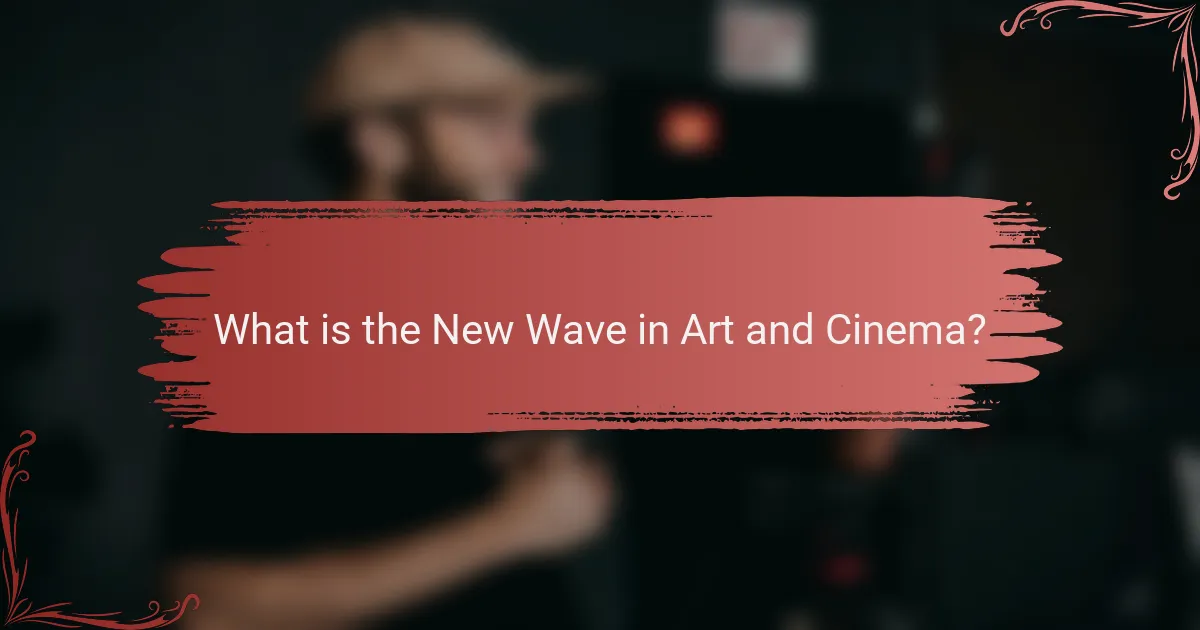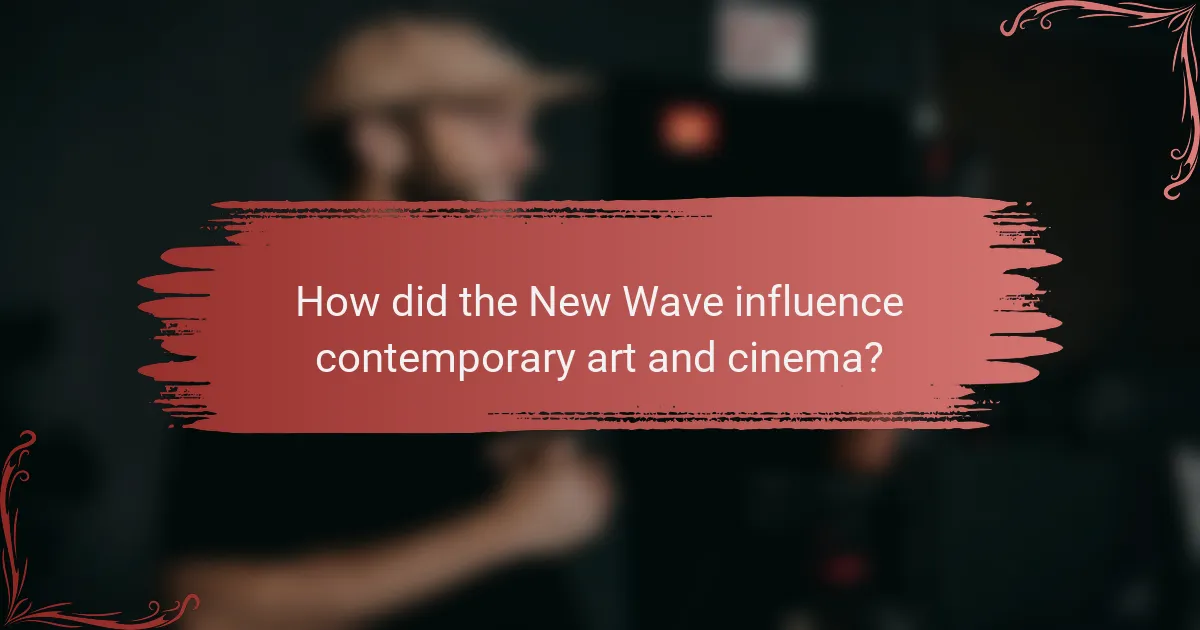The New Wave in Art and Cinema is a significant movement that emerged in France during the late 1950s and 1960s, characterized by innovative storytelling and visual techniques that challenged traditional narrative structures. Key figures such as François Truffaut and Jean-Luc Godard utilized handheld cameras and natural lighting to create a sense of realism and intimacy in their films. Major works like “Breathless” and “The 400 Blows” exemplify the movement’s focus on personal expression and stylistic experimentation. The New Wave’s influence continues to be felt in contemporary cinema and art, inspiring filmmakers to explore unconventional themes and methods.

What is the New Wave in Art and Cinema?
The New Wave in Art and Cinema refers to a movement that emerged in the late 1950s and 1960s. It primarily originated in France and is characterized by innovative storytelling and visual techniques. This movement challenged traditional narrative structures and embraced spontaneity. Directors like François Truffaut and Jean-Luc Godard were key figures in this movement. They often used handheld cameras and natural lighting. This approach created a sense of realism and intimacy. The New Wave also emphasized personal expression and the role of the filmmaker. Its influence can be seen in contemporary cinema and art today.
How did the New Wave movement originate?
The New Wave movement originated in the late 1950s and early 1960s as a response to traditional filmmaking. It emerged primarily in France, influenced by the rise of auteur theory. Filmmakers sought to break away from established cinematic conventions. They experimented with narrative structure, visual style, and editing techniques. Directors like François Truffaut and Jean-Luc Godard were key figures in this movement. Their films often featured unconventional storytelling and a focus on personal expression. The movement was also fueled by the accessibility of lightweight cameras and portable sound equipment. This technological shift allowed filmmakers to create more spontaneous and innovative works.
What historical and cultural contexts influenced the New Wave?
The New Wave was influenced by historical and cultural contexts including post-World War II disillusionment. This period saw a rejection of traditional filmmaking techniques. The rise of youth culture in the 1960s also played a significant role. Filmmakers sought to express new ideas and perspectives. Influences included the French New Wave’s embrace of realism and spontaneity. Additionally, the advent of portable cameras allowed for innovative storytelling methods. The political climate of the time, characterized by social upheaval, further shaped cinematic narratives. These contexts collectively contributed to the emergence of the New Wave as a transformative movement in cinema.
Who were the key figures in the New Wave movement?
The key figures in the New Wave movement include François Truffaut, Jean-Luc Godard, and Agnès Varda. François Truffaut was known for his film “The 400 Blows,” which showcased innovative storytelling. Jean-Luc Godard directed “Breathless,” a film that challenged traditional cinematic techniques. Agnès Varda, a prominent female director, contributed significantly with her film “Cléo from 5 to 7.” These filmmakers were instrumental in shaping the New Wave’s unique style. They emphasized personal expression and often broke conventional narrative structures. Their works collectively influenced modern cinema and inspired future generations of filmmakers.
What are the defining characteristics of New Wave techniques?
New Wave techniques are characterized by their experimental approach and innovative storytelling methods. These techniques often break traditional narrative structures. They incorporate non-linear timelines and fragmented narratives. Visual style plays a significant role, featuring bold colors and unconventional camera angles. The use of natural lighting and location shooting is prevalent. Character development is often complex and psychologically nuanced. Dialogue tends to be realistic and conversational. These characteristics reflect a departure from classical filmmaking conventions, emphasizing artistic expression and cultural commentary.
How do these techniques differ from traditional methods?
These techniques differ from traditional methods by emphasizing innovation and efficiency. Traditional methods often rely on established practices that can be slow and rigid. In contrast, new techniques focus on adaptability and real-time problem-solving. For example, many modern techniques utilize technology for data analysis, enhancing accuracy and speed. Traditional methods may lack this technological integration, leading to longer processing times. Additionally, revolutionary techniques often prioritize collaboration and interdisciplinary approaches, unlike traditional methods that may silo expertise. This shift fosters creativity and diverse perspectives, resulting in more holistic solutions.
What innovative storytelling approaches emerged from the New Wave?
The New Wave introduced several innovative storytelling approaches, including non-linear narratives and fragmented timelines. Filmmakers often prioritized character development over plot, allowing for deeper emotional engagement. They embraced realism, often using location shooting and natural lighting to enhance authenticity. Additionally, the use of jump cuts became prominent, breaking traditional editing conventions. This technique created a sense of urgency and immediacy in storytelling. Many New Wave films also featured self-referential elements, blurring the lines between fiction and reality. These approaches shifted the focus from conventional storytelling to more experimental forms. The impact of these methods can be seen in later cinematic movements and contemporary films.

What are the major works associated with the New Wave?
Major works associated with the New Wave include “Breathless” by Jean-Luc Godard and “The 400 Blows” by François Truffaut. “Breathless,” released in 1960, is known for its innovative editing and narrative style. It significantly influenced the development of modern cinema. “The 400 Blows,” also released in 1959, is a seminal film that explores themes of adolescence and rebellion. Both films are foundational to the New Wave movement. Other notable works include “Cléo from 5 to 7” by Agnès Varda and “Jules and Jim” by François Truffaut. These films exemplify the movement’s emphasis on personal storytelling and stylistic experimentation.
Which films are considered seminal in the New Wave movement?
Seminal films in the New Wave movement include “Breathless,” “Jules and Jim,” and “The 400 Blows.” “Breathless,” directed by Jean-Luc Godard in 1960, is often credited with defining the movement’s style. It introduced jump cuts and a more spontaneous narrative approach. “Jules and Jim,” directed by François Truffaut in 1962, showcased innovative storytelling and character development. “The 400 Blows,” also by Truffaut, released in 1959, is a poignant exploration of youth and rebellion. These films collectively revolutionized cinematic techniques and influenced future directors.
What themes are prevalent in these major works?
Prevalent themes in major works of the New Wave include existentialism, fragmentation, and social critique. Existentialism explores the human condition and individual freedom. Fragmentation reflects the disjointed nature of modern life and perception. Social critique addresses political and cultural issues, often challenging societal norms. These themes are evident in films like “Breathless” and “The 400 Blows.” They highlight characters grappling with identity and societal constraints. The New Wave’s emphasis on personal experience further reinforces these themes.
How did these works impact the film industry?
These works significantly transformed the film industry by introducing innovative narrative techniques and visual styles. The New Wave filmmakers challenged traditional storytelling methods. They utilized jump cuts, non-linear narratives, and unconventional character development. This approach influenced future filmmakers to experiment with form and content. The movement emphasized personal expression and authenticity in cinema. Films like “Breathless” and “The 400 Blows” showcased these techniques. These works inspired a generation of directors worldwide. They laid the groundwork for modern independent cinema and auteur theory.
What role did literature play in shaping New Wave cinema?
Literature significantly influenced New Wave cinema by providing narrative structures and thematic depth. Filmmakers drew inspiration from literary movements, particularly existentialism and modernism. This connection is evident in the emphasis on character-driven stories and fragmented narratives. Directors like François Truffaut and Jean-Luc Godard adapted literary techniques into their films. For example, Godard’s “Breathless” reflects the influence of American crime novels. The use of voice-over narration in many New Wave films mirrors literary storytelling. Furthermore, literary references enriched the dialogue, adding layers of meaning. This integration of literature allowed New Wave cinema to explore complex human experiences. Ultimately, literature served as a foundational element in the evolution of New Wave cinema.
Which literary influences are evident in key New Wave films?
Key New Wave films exhibit influences from existentialism and modernist literature. Directors like Jean-Luc Godard drew inspiration from writers such as Albert Camus and Franz Kafka. Their themes of alienation and absurdity are mirrored in the narratives of films like “Breathless.” Additionally, the fragmented storytelling techniques reflect modernist styles found in the works of Virginia Woolf and James Joyce. The use of stream-of-consciousness and non-linear narratives in films emphasizes character introspection. These literary influences helped shape the innovative storytelling methods characteristic of the New Wave movement.
How did adaptations from literature contribute to the movement?
Adaptations from literature significantly contributed to the New Wave movement by providing rich narratives and innovative storytelling techniques. These adaptations often transformed classic texts into contemporary cinematic experiences. Filmmakers drew inspiration from literary works to explore complex themes and character development. For example, the adaptation of literary classics allowed directors to experiment with non-linear narratives. This approach challenged traditional storytelling methods and engaged audiences in new ways. Additionally, adaptations often incorporated visual styles that reflected the literary source’s tone and mood. This synergy between literature and film enhanced the artistic depth of the New Wave movement. Such adaptations also attracted a broader audience, bridging the gap between literature enthusiasts and filmgoers.

How did the New Wave influence contemporary art and cinema?
The New Wave significantly influenced contemporary art and cinema through innovative storytelling and visual techniques. It introduced a departure from traditional narrative structures. Filmmakers utilized handheld cameras and natural lighting for a more authentic feel. This technique created a sense of immediacy and intimacy. Additionally, the New Wave emphasized personal expression and subjective viewpoints. Directors like Jean-Luc Godard and François Truffaut challenged cinematic norms. Their works inspired future filmmakers to explore unconventional themes and styles. The movement’s impact is evident in the rise of independent cinema and experimental art forms today.
What lasting effects has the New Wave had on modern filmmakers?
The New Wave has significantly influenced modern filmmakers through its innovative techniques and narrative styles. It introduced a more personal and subjective approach to storytelling. Directors began to prioritize character-driven plots over traditional narratives. The use of handheld cameras became popular, creating a more intimate viewing experience. Non-linear storytelling emerged as a common technique, allowing for greater creative freedom. Filmmakers also embraced realism, often using natural lighting and real locations. The New Wave’s focus on youth culture and social issues resonated with audiences, shaping contemporary themes. This movement laid the groundwork for future movements, such as independent cinema and the rise of auteur filmmaking.
In what ways do contemporary films reflect New Wave techniques?
Contemporary films reflect New Wave techniques through innovative storytelling, non-linear narratives, and breaking traditional cinematic conventions. They often employ jump cuts, a hallmark of New Wave cinema, to create a sense of urgency and disorientation. Additionally, contemporary films frequently feature handheld camera work, enhancing realism and intimacy. Character-driven plots are prevalent, focusing on personal journeys rather than grand narratives. The use of natural lighting and on-location shooting mimics the authentic aesthetic of New Wave films. Moreover, contemporary filmmakers often experiment with genre blending, reflecting the New Wave’s challenge to categorization. This influence is evident in films such as “Birdman” and “Frances Ha,” which showcase these techniques effectively.
How has the New Wave inspired new artistic movements?
The New Wave has inspired new artistic movements by introducing innovative techniques and narrative styles. This cinematic movement began in the late 1950s in France. It emphasized experimentation and a break from traditional storytelling. Filmmakers like Jean-Luc Godard and François Truffaut challenged conventional norms. Their use of jump cuts and non-linear narratives influenced various art forms. The New Wave’s focus on realism and personal expression resonated with contemporary artists. It paved the way for movements such as independent cinema and postmodern art. The impact of the New Wave is evident in the works of directors like Quentin Tarantino and Richard Linklater. These artists draw on its principles to create unique cinematic experiences.
What can we learn from the New Wave for future artistic endeavors?
The New Wave teaches us the value of innovation and experimentation in artistic endeavors. It emphasized breaking traditional norms and embracing new forms of expression. Filmmakers like François Truffaut and Jean-Luc Godard challenged conventional storytelling techniques. They introduced jump cuts and non-linear narratives, which reshaped audience expectations. This movement also highlighted the importance of personal voice and authenticity in art. By focusing on character-driven stories, artists can create deeper connections with audiences. Furthermore, the New Wave demonstrated that low-budget productions can yield significant artistic impact. This encourages future creators to pursue unique visions regardless of financial constraints. Overall, the New Wave’s legacy inspires continued exploration and redefinition of artistic boundaries.
What best practices can emerging artists adopt from the New Wave?
Emerging artists can adopt several best practices from the New Wave movement. They should embrace experimentation with form and content. New Wave artists often blended genres and broke traditional narrative structures. This approach fosters creativity and innovation. Additionally, artists can focus on personal storytelling. New Wave emphasized individual perspectives and authentic voices. Engaging with social and political themes can also resonate with audiences. The New Wave often reflected contemporary issues, enhancing relevance. Finally, leveraging new technologies and media is crucial. This movement utilized emerging film techniques and styles to push boundaries. These practices encourage originality and audience connection in today’s artistic landscape.
How can understanding the New Wave enhance our appreciation of current art and cinema?
Understanding the New Wave enhances appreciation of current art and cinema by highlighting innovative techniques and thematic exploration. The New Wave movement introduced groundbreaking narrative styles and visual aesthetics that continue to influence filmmakers today. For instance, its use of jump cuts and non-linear storytelling has become a staple in modern cinema.
Additionally, the New Wave’s focus on personal storytelling and character-driven plots resonates in contemporary films. This movement encouraged filmmakers to challenge traditional norms and explore complex social themes. By studying the New Wave, audiences can recognize these influences and appreciate the evolution of cinematic language.
Moreover, the cultural context of the New Wave reflects a shift in societal values that informs current artistic expressions. Understanding this historical backdrop fosters a deeper connection with contemporary works, revealing layers of meaning and intention. Through this lens, viewers can appreciate the continuity and transformation of artistic expression across generations.
The main entity of the article is the New Wave movement in art and cinema, which emerged in France during the late 1950s and 1960s. The article outlines the movement’s revolutionary techniques, such as innovative storytelling, non-linear narratives, and the use of handheld cameras, which challenged traditional filmmaking conventions. Key figures like François Truffaut, Jean-Luc Godard, and Agnès Varda are highlighted, along with seminal works such as “Breathless” and “The 400 Blows.” Additionally, the article discusses the historical and cultural contexts that influenced the New Wave, its lasting impact on contemporary cinema, and the lessons emerging artists can learn from this transformative movement.
